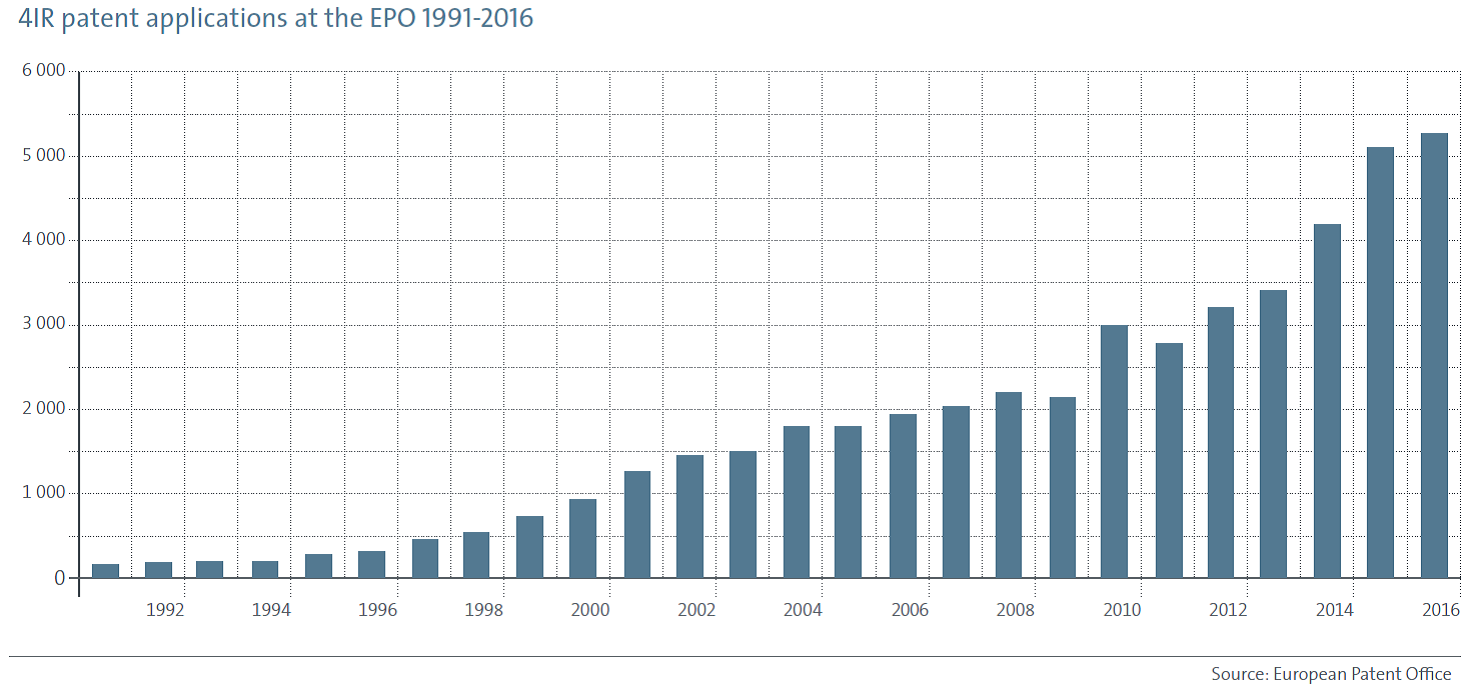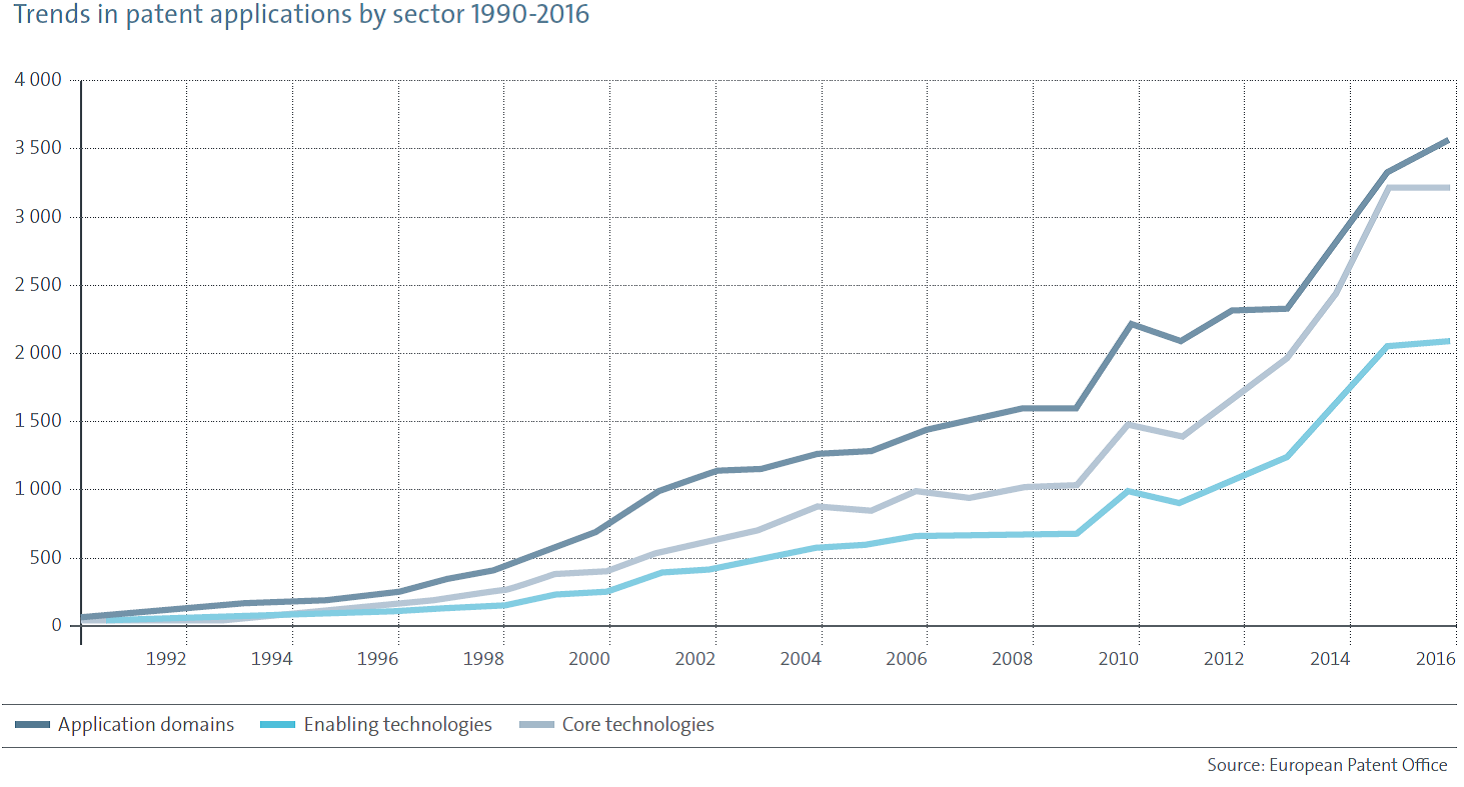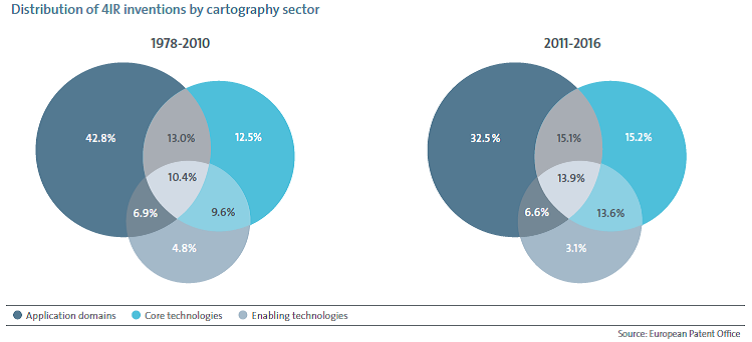
Reading the Future Through Patents
4th Industrial Revolution (4IR)
Within the past decade, we have been experiencing a rapid transformation in our everyday life which can simply be described as digitalisation. Expanding network of connected devices, data analytics, artificial intelligence, virtual and augmented reality technologies have transformed the way we perceive and interact with our environment. This extensive digitalisation of everyday activities is happening in a way that makes it harder to distinguish different fields of technologies from each other, fusing physical world with digital and biological features. Tendencies in this respect can be seen in “smart” factories, transportation (autonomous vehicles), energy (smart grids), healthcare (health tracking applications), agriculture and many other fields. This transformation is now described as 4th Industrial Revolution (4IR).
Through studying patent applications, it is possible to observe the emergence and development of the scientific developments and influential technologies which are main drivers of the 4IR. The European Patent Office (EPO) recently published an extensive landscaping study relating to patents and the 4IR, highlighting main innovation trends.

Findings suggest that the technologies relating to the 4IR (see below) are changing and becoming more interdisciplinary while Europe is holding its position as a strong hub for innovation in technologies relating to the 4IR.
In order to identify what constitutes technology of the 4IR, the EPO presents three sectors (see page 23 of the full EPO Study) that cover the related technologies. These include:
- Core Technologies: This sector corresponds to the basic building blocks, namely the hardware, software and connectivity, upon which the technologies of the 4IR are built and which makes it possible to transform any object into a smart and connected device.
- Enabling Technologies: This sector captures the enabling technologies that build upon and complement the core technologies, including analytics, user interface, 3-dimensional support systems, artificial intelligence, position determination, power supply and security.
- Application Domains: This sector covers the end point of the applications of the 4IR where the technology meets the end-users in various parts of the economy (personal, home, vehicles, enterprise, manufacture, infrastructure)

The Messages Hidden in Patent Applications Trends
By using this classification, the EPO identified over 48,000 published and unpublished patent applications that relate to 4IR technologies, which were filed before 2017.
Upon categorising these patent applications in accordance with above classification, the ”Application Domains” sector appear to be the sector where most patent applications are filed (70.6%).
Some of the key findings of this study include:
- 5000 patent applications for inventions relating to “autonomous objects” filed at the EPO in 2016.
- The number of patent filings relating to 4IR inventions has increased in the last three years by 54%, whereas the overall number of patent filings over the same period has increased by only 7.65% in comparison.
- Inventions relating to “connectivity” (core technologies), and inventions relating to “personal and enterprise” (application domains) represent the highest number of patent applications relating to 4IR technology.
- The divisions of “3D systems”, “artificial intelligence” and “user interface” demonstrate highest increase rate of applications.
- Patent applications in Europe show the tendency toward vehicles, infrastructure and manufacturing (Germany) as well as artificial intelligence, security, user interface and 3D systems (France).
- Innovation in core technologies is driven by few large companies focusing on information & communication technologies (ICT).
- Inventions in the “enabling technologies” and “application domain” sectors come from a larger variety of industries.
- Technology convergence appears to be another key topic to consider as the trends suggest significant increase in the overlaps between the different 4IR technology sectors.
The Implications of the Findings
These sorts of radical movements force organisations to rethink their business models as well as their operations. In addition to training of the 4IR workforce (e.g. teaching the staff members how to use a new set of “smart” tools or a “predictive analysis” software), new digital infrastructures require careful regulation (legal framework for ensuring cyber-security, market competition, consumer rights) and support for sustainable establishment as well as future growth. This may lead to expansion of existing activity areas (e.g. protection of personal information in wearable technologies) or even creation of brand new fields (e.g. blockchain and crypto-currency).
Due to technological developments and market requirements, inventions are being forced to combine more features enabling them to be assigned to multiple technological fields. Accordingly, the EPO study suggests that the integration of core and enabling technologies into subgroups of the application domain sector will drive the economic impact of the 4IR.

Technology profiles of the 4IR also indicate geographical specialisation different technology sectors. For example, European countries have a preference for the “connectivity” division of the core technology sector. Further specialisation patterns can be seen at country level as well (see page 80-81 of full EPO Study).
One of the clearest indication of this study is that computer implemented inventions are and will continue to be the main driver of 4IR innovation and technological development with an increased convergence towards various other technological fields.
For full article: http://www.epo.org/news-issues/news/2017/20171211.html








